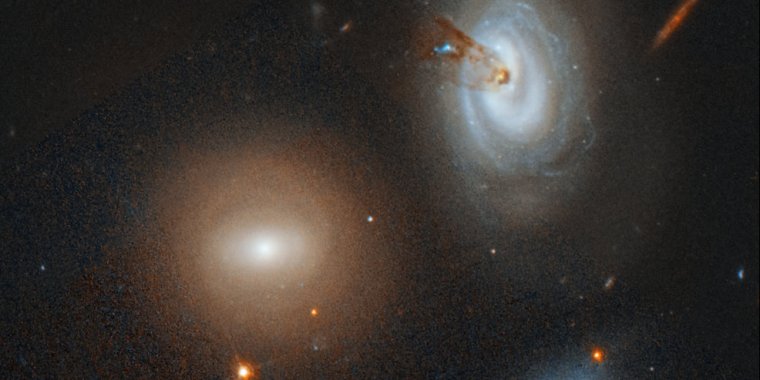| News / Space News |
Hubble Sees Plunging Galaxy Losing Its Gas
The rough-and-tumble environment near the center of the massive Coma galaxy cluster is no match for a wayward spiral galaxy. New images from NASA's Hubble Space Telescope show a spiral galaxy being stripped of its gas as it plunges toward the cluster’s center.

The spiral galaxy D100, on the far right of this Hubble Space Telescope image, is being stripped of its gas as it plunges toward the center of the giant Coma galaxy cluster. The dark brown streaks near D100's central region are silhouettes of dust escaping from the galaxy. The dust is part of a long, thin tail, also composed of hydrogen gas, that stretches like taffy from the galaxy's core. Hubble, however, sees only the dust. The telescope's sharp vision also uncovered the blue glow of clumps of young stars in the tail. The brightest clump in the middle of the tail (the blue feature) contains at least 200,000 stars, fueled by the ongoing loss of hydrogen gas from D100. ![]()
A long, thin streamer of gas and dust stretches like taffy from the galaxy's core and on into space. Eventually, the galaxy, named D100, will lose all of its gas and become a dead relic, deprived of the material to create new stars and shining only by the feeble glow of old, red stars.
Called "ram pressure stripping," the process occurs when a galaxy, due to the pull of gravity, falls toward the dense center of a massive cluster of thousands of galaxies, which swarm around like a hive of bees. During its plunge, the galaxy plows through intergalactic material, like a boat moving through water.
The material pushes gas and dust from the galaxy. Once the galaxy loses all of its hydrogen gas — fuel for starbirth — it meets an untimely death because it can no longer create new stars. The gas-stripping process in D100 began roughly 300 million years ago.
In the massive Coma cluster this violent gas-loss process occurs in many galaxies. But D100 is unique in several ways. Its long, thin tail is its most unusual feature. The tail, a mixture of dust and hydrogen gas, extends nearly 200,000 light-years, about the width of two Milky Way galaxies. But the pencil-like structure is comparatively narrow, only 7,000 light-years wide.
The tail is remarkably well-defined, straight and smooth, and has clear edges. This is a surprise because a tail like this is not seen in most computer simulations. Most galaxies undergoing this process are more of a mess. The clean edges and filamentary structures of the tail suggest that magnetic fields play a prominent role in shaping it.
Computer simulations show that magnetic fields form filaments in the tail's gas. With no magnetic fields, the tail is more clumpy than filamentary.
The researchers' main goal was to study star formation along the tail. Hubble's sharp vision uncovered the blue glow of clumps of young stars. The brightest clump in the middle of the tail contains at least 200,000 stars, triggered by the ongoing gas loss from the galaxy.
However, based on the amount of glowing hydrogen gas contained in the tail, the team had expected Hubble to uncover three times more stars than it detected.
Adding to this compelling narrative is another galaxy, appearing to the lower left of D100 in the image, that foreshadows D100's fate. The object, named D99, began as a spiral galaxy similar in mass to D100. It underwent the same violent gas-loss process as D100 is now undergoing, and is now a dead relic.
All of the gas was siphoned from D99 between 500 million and 1 billion years ago. Its spiral structure has mostly faded away, and its stellar inhabitants consist of old, red stars. D100 will look like D99 in a few hundred million years. (NASA)
YOU MAY ALSO LIKE
